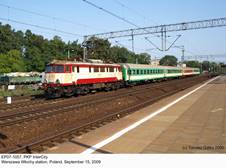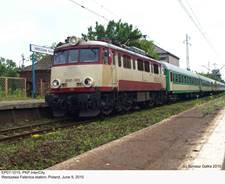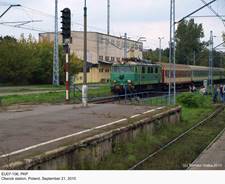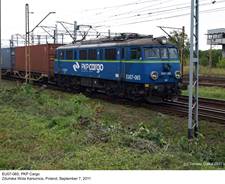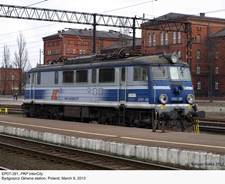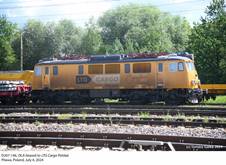EU07 and EP07
|
|||||||||||||||||||||||||||||||||||||||||||||||||||||||||||||||||||||||||||||||||||||||||||||||||||||||||||||||||||||||||||||||||||||||||||||||||||||||||||||||||||||||||||||||||||||||||
|
First example from Pafawag
(EU07-001, s/n 1/1964) at Chabówka rolling stock
heritage park, Over two years later things are not looking
much better, but restoration seems to be under way: Chabówka,
July 29, 2006. EU07-001 in its better days; location and
date unknown. Photo from my collection. EU07-027 at
Stalowa Wola Rozwadów station, May 4, 2004. EU07-144 at
Piotrków Trybunalski loco depot, October 29, 2001. EU07-114 with train
220 to Wrocław near Jaworzyna Śląska, August 4,
2004. EU07-408 near Warszawa Rembertów
station, January 29, 2003… …EP07-344, photographed on the same occasion… … and the same example in Ełk,
August 1, 2004. EP07-522 near Warszawa Wawer
station, August 8, 2002 (note rectangular headlights – then a novelty). EP07-383 in Gdańsk,
August 6, 2003 (as above). EU07, early version from Pafawag;
side drawing from the factory folder, issued probably in late 1960s. EU07 from Pafawag,
later variant; side drawing by M. Ćwikła (SK
vol. 9/2002). EU07, late version from HCP with some modifications; side drawing by M. Ćwikła (SK vol. 10/2002). EP07-355, photographed near the Łódź Widzew station on April
10, 2005. EU07-112 at the Krotoszyn
station, April 13, 2005. Several pictures taken at the Warszawa Wschodnia station can be seen here. Leased EU07s, operated by Koleje
Mazowieckie, can be seen here. EP07-388, photographed near the Warszawa Zachodnia station, February 17, 2007. EP07-332, photographed in Ełk
on June 15, 2006... ...and EP07-345, photographed on the same
occasion. The same locomotive, photographed in Warsaw
on October 14, 2008, in (then) new PKP InterCity blue livery. Two EU07s, photographed near the Warszawa Olszynka Grochowska depot on
July 11, 2006: EU07-325... ... and EU07-153. EU07-318 with a passenger train arriving in Leszno
on July 26, 2006. Two EU07s, photographed at the Kraków Płaszów station on
September 9, 2006: EU07-531... ...and slightly battered EU07-321; traces of
yellow paint on the front panel are still visible. Two locomotives photographed near Rogów station on November 22, 2006: EU07-124... ...and EU07-495. EU07-367
passes by EP07-388; Warszawa Zachodnia, February 17, 2007. Early production EU07-010, photographed in Kalwaria Zebrzydowska on May 3, 2007. EP07-211, photographed near the Warszawa Olszynka Grochowska depot on
July 26, 2007. EU07-494, Gdynia Grabówek
depot, August 23, 2007. EP07-375, photographed near the Warszawa Zachodnia station on October 24, 2007. Modernized EP07-1005 (ex EU07-352),
photographed at one of my favorite spots near the Warszawa Zachodnia station on October 26, 2007. Note missing
multiple control sockets. More photos from this location can be seen here. EU07-496, photographed somewhere in Poland in
June 1995... ...and the same machine photographed after a
crash on August 17, 1995. Both photos from my collection. In 2008, modernized EP07-1051 (ex EU07-054)
was externally made up as BR class
83 in the 1960s livery; photo taken in Wolsztyn on
May 3, 2008. Another picture of this locomotive, taken at
the Wrocław Główny
station in June 2008 by John Bryant (thanks for permission!). More pictures
of EU07s and EP07s from Wrocław can be found here. Two locomotives, photographed at the Poznań Główny station on May
15, 2008: EU07-417... ...and modernized EP07-1002 (ex EU07-147). EU07-127, photographed at the Gliwice station
on June 15, 2008. EU07-096, photographed in Węgliniec
on July 16, 2008. Modernized EP07-1053, photographed on the
same occasion. EP07-1055, photographed in Korsze on September 9, 2008. Electrified line ends there
and eastbound trains are taken over by SU45s or SU46s. EP07-1052, Olsztyn Główny
station, September 12, 2008. EP07-1018, photographed on the same occasion. Three modernized EP07s, photographed at the
Olsztyn depot on the same day. This EP07-389 was photographed at the Zduńska Wola Karsznice station on October 20, 2008; freighters are
much more frequent visitors there. EU07-013, Poznań Franowo, eight days later. Two pictures, taken at the Jelenia Góra station on November 29, 2008: modernized EP07-1003
(ex EU07-486)… …and ‘old’ EU07-223. EP07-1022, photographed in Węgliniec on March
20, 2009. PKP Przewozy Regionalne
logo has been removed and small PKP InterCity logo can now be seen. EU07-123 in new PKP Cargo livery,
photographed at the Bielsko-Biała station on April
26, 2009. Two pictures, taken at the Bohumin station, Czech Republic, on April 27, 2009.
EU07-533 is ready to depart with a train to Warsaw (individual name ‘Hanka’ in the front wall is rather uncommon)… …while EU07-446 is waiting for an assignment,
accompanied by three Czech 163s. EU07-490, photographed at the Rzepin station on May 15, 2009… …and EP07-1001, first locomotive modernized
to this standard, photographed on the same occasion. Here PKP locos
take over passenger trains from Germany. Modernized
EP07-1056, Warszawa Zachodnia, May 28, 2009. EP07-1030 with a train from Lublin approaches
Warszawa Miedzeszyn station (a few hundred metres from my home); March 4, 2010. EU07-342, PKP InterCity, approaches
the Grodzisk Mazowiecki station; September 2, 2009. EP07-541, photographed at the Warszawa Radość station on the same day. Three locomotives, photographed at the
Warszawa Włochy station on September 15, 2009, also
represent various livery variants: EU07-466… …EU07-491… …and EP07-1057. Three pictures, taken at the Kraków Płaszów station on
November 25, 2009: EU07-208… …EP07-233 (with an EN57 EMU in the
background)… …and EU07-005 (second oldest EU07 then still
in service). EP07-1015 passing through Warszawa Falenica station – not far from where I live. June 9,
2010. EU07-106 with a train to Lublin approaches
the Otwock station on September 21, 2010. Winter delights: EP07-434, photographed near
Warszawa Radość station on December 15, 2010. Quite by chance, next in the service number
sequence EU07-435, but photographed in totally different environment, on a
flooded track near Gdańsk in July 2001. This is a charity
postcard, issued to raise funds for flood victims. EU07-091, photographed in Tomaszów
Mazowiecki on May 11, 2011. Following purchase of modern electric
locomotives from Bombardier and Siemens, more and more EU07s
are encountered with freight trains. This EU07-123 from the PKP Cargo
fleet was photographed with a draft of cement cars at the Zduńska
Wola Karsznice station on
June 17, 2011. The same location: EU07-065 with a freight
train. September 7, 2011. Two PKP InterCity locomotives,
photographed at the Łódź Fabryczna
station on September 21, 2011: EP07-517 (note multiple control sockets faired
over)… …and EU07-377, the latter just having arrived
from Warsaw. This EU07-210 was leased to Koleje Mazowieckie
and then returned to PKP Cargo, in the original livery (minus
operator’s logo); Zduńska Wola
Karsznice, December 19, 2011. One of the few EU07s used by private
operators: EU07-80, PHU Lokomotiv, Długołęka, December 21, 2011. EU07-244, PKP InterCity, leaves the Sędziszów station; January 8, 2012. EU07-209, PKP Cargo (previously leased
to Koleje Mazowieckie),
photographed in Długołęka on April 27, 2012. EP07-351, photographed in Koluszki
on June 17, 2012. EU07-144 with a draft of container cars,
photographed in Zduńska Wola
Karsznice on July 23, 2012. The same location: EU07-1519 with a draft of
container cars. September 12, 2012. EU07-239, photographed in Korsze
on September 1, 2012. Electrified line ends there. Three locomotives photographed at the
Bydgoszcz Główna station on March 9, 2013:
EP07-312… …EP07-434… …and EP07-391. EP07-1030,
Skarżysko Kamienna station, May 29, 2013. A few photos from my collection. EP07-350,
Szczecin Port Centralny depot, February 10, 2000
(photo by Tomasz Grabowski). Snow-covered EU07-177, location and date
unknown. EU07-418 with ET22-413 in the background,
location and date unknown (photo by D. Szymczyk). EU07-394,
Gryfino, December 25, 2000 (photo
by D. Szymczyk). EU07-182, location and date unknown (photo by
D. Szymczyk). EU07-435,
Gryfino, March 4, 2001 (photo by D. Szymczyk). EU07-187, photographed while passing by the Ostrowite station, displays new Przewozy
Regionalne livery; June 15, 2013. Six locomotives photographed at the Kraków Płaszów station on June
20, 2013: EU07-173… …EP07-412… …EU07-052… …EP07-1066… …EU07-092… …and EP07-135. Two pictures taken at the Gdynia Główna station on September 23, 2013: EP07-442… …and EP07-1025. EU07-1509, PKP Cargo, photographed in Zduńska Wola Karsznice on December 11, 2013. Damaged EU07-471, date and location unknown (photo from my
collection). Possibly this picture was taken after a crash in Grajewo in July 1998 – the locomotive was not rebuilt
afterwards. EU07-437, Gryfino, July 11, 2000. Photo by D.Szymczyk (from my collection). Another picture from my collection: EU07-486, Szczecin, date and
author unknown. EU07-468 with a freight train, photographed
in Gliwice on March 26, 2015. Four pictures taken at the Olsztyn Główny station: EP07-1010, July 1, 2015… …EP07-1036, the same date… …EP07-382, the next day… …and EP07-1007, the same date. Better overall condition, but still far from
pristine: EU07-001, Chabówka railway heritage park,
May 6, 2017. EU07-092, photographed near the Chabówka station on the same day. Two locomotives photographed at the Dęblin station on July 28, 2017: EP07-1001… … and EP07-1002, both from the PKP InterCity fleet. Weary-looking EU07-077, photographed at the
same location on September 24, 2017. EU07-240, sold to a private operator in 2014,
has changed owner several times and is currently operated by Sandomierz-based ZIK
company… … while EU07-109, sold in 2013 (see the
Warszawa Wschodnia section) is currently owned by Industrial Division trading and
leasing company. Both were photographed in Sandomierz
on November 5, 2017. Another picture from this location: EU07-454
operated by Captrain Polska,
February 25, 2018. EP07-389, photographed at the Poznań Główny station on April
25, 2018. Another picture from this location: EP07-1044
(rebuilt EU07-507), May 8, 2019. Powroźnik station in southern Poland: EP07-338 from the PKP InterCity fleet sporting a ʽhistorical‘ green livery. May 3, 2019. This locomotive sometimes runs with
special trains. EU07E-206, owned by Industrial Division company and leased to Captrain Polska; Sandomierz,
June 2, 2019. EP07-1009
(rebuilt EP07-518), Warszawa Zachodnia station, February 15, 2020. EP07-1058 (rebuilt EU07-163), photographed in
Jelenia Góra on September 9, 2022. EU07-009, built in 1967, was sold to a
leasing company in July 2011 and has changed hands several times since then.
Currently it is operated by ZIK Sandomierz. Sandomierz,
February 25, 2024. EU07-146 was withdrawn from PKP InterCity in October 2021;
initially intended for scrapping, it was sold to DLA in November 2022 and then leased to LTG Cargo Polska. Pilawa,
July 4, 2024. EP07-1068 (modernized EU07-042), photographed
at the same location on August 1, 2024. Three EU07s, modernized to the 303Eb
standard, photographed at the Warszawa Praga
station on August 8, 2024: EU07-1506 (ex EU07-404)… … EU07-1512 (ex EU07-475)… … and EU07-1508 (ex EU07-451). All are
operated by PKP Cargo. Another ‘freighter’: EU07-1520 (rebuilt
EU07-504), PKP Cargo, Puławy Azoty station, October
20, 2024… … and yet another one: EU07-1523 (rebuilt
EU07-202), PKP Cargo, Warszawa Praga station, November 7, 2024. The same location and another picture of the
EU07-1520: February 27, 2025. 4E-004 (former EU07-125), owned by Wiskol and
leased to various operators; location and date unknown. Source: www.wiskol.pl. |
Efforts to design and build electric locomotives for
passenger and express trains in Poland after WWII were not entirely
successful. EP02, which in fact was a derivative of pre-war EL.100 of British
origin, had poor running qualities and was never considered wholly suitable
for large-scale production; only eight examples were built and their service
was comparatively short. Next electric passenger locomotives were imported
from Sweden, East Germany, Czechoslovakia and UK. In the meantime, indigenous (although based on
Soviet VL22M) ET21 freight locomotive went into production at Pafawag (pre-war Linke-Hofmann)
in Wrocław in 1957. This machine was considered
successful and certainly paved the way for more advanced designs. It was,
however, decided to build a license locomotive rather than develop an
entirely new one. The choice fell on British EU06, of which twenty examples
had been ordered in 1961. From the very beginning it was stipulated that
license agreement should follow immediately and until 1965 PKP should have received about 100
examples built in Wrocław under factory designation
4E. These plans turned out over-optimistic. First locomotive, with service
number EU07-001, was rolled out in December 1964 and accepted for service
tests in April 1965. Until the end of 1966 only four EU07s were accepted and
sixteen followed in 1967. Large-scale production started the next year. Despite new service designation, EU07 did not differ
much from British-built EU06 and had similar performance and appearance.
Differences concerned mainly those items of equipment that had already been
manufactured in Poland and thus were not covered by license agreement (such
as compressors or heating devices). Service designation implies that this
machine was suitable both for passenger and freight trains, but initially was
seldom used for freight service. In fact, due to its introduction, it was
possible in 1970 to withdraw ET21s from passenger traffic, for which they
were certainly not well suited. Production of EU07 at Pafawag
lasted until 1974 and totaled 240 examples, the last of which was accepted by
PKP in January 1975. Four more were
rebuilt from EP08s in 1976 and 1977. Further deliveries were halted, as
freight locomotives were more urgently needed: this may seem hard to explain,
but in fact electrification did not progress as fast as previously planned
and main effort was concentrated on principal trunk routes, where heavy
freight traffic dominated. As Pafawag was
then the sole producer of electric locomotives in Poland, they had to shift
to ET22, which in fact owed something to EU07 (e.g. electric motors were of
the same type). Alternative to electrification was sought in diesel
locomotives and PKP acquired over
1800 heavy road diesels, mostly from the USSR (class ST44). However, due to
drastic increase of fuel prices, this policy had to be revised and in 1981 it
was decided to concentrate available resources on electrification – once
again. As Pafawag was involved in the ET22
program, new passenger machines were to be built by HCP of Poznań. This large factory had
not built electric locomotives before 1977, when ET41 made its appearance;
this two-section heavy freighter had in fact been derived from EU07 and had
the same traction motors. Original plans called for about 500 examples, but eventually
only 200 were built. Although HCP
design bureau produced original designs of fast passenger locomotives, it
soon became obvious that they had little chances to materialize, if any,
especially after martial law introduction in Poland in December 1981, when
import of certain items of equipment became impossible. It was therefore
decided to revive the EU07 program, but on the basis of experience gained
with the ET41. First example of the ‘new’ machine (factory designation 303E)
was delivered in August 1983 – over eight years after the last EU07 from Pafawag. In PKP
service, machines from HCP were
given service numbers from EU07-301 onwards (last of the ‘old’ batch from Pafawag was EU07-244, rebuilt from EP08-003
and delivered in November 1977). Machines from Poznań
differed from earlier ones mainly internally. First of all, frame was
redesigned in order to simplify manufacture, so new machines were longer by
320 mm and heavier by almost 3.5 tonnes. There
were, of course, many differences concerning individual items of equipment.
Wheelsets and engines were the same as in earlier examples. Externally, the
easiest way to distinguish later machines from the earlier ones – apart from
the service number – is the fact that EU07s from HCP had side walls made of riffled plates and larger pilots.
Their production totaled 242 examples, the last of which – EU07-543 – was
delivered in June 1992. Furthermore, three machines were rebuilt from damaged
ET41s (EU07-537 from ET41-036B, EU07-544 from ET41-088A and EU07-545 from
ET41-116A), so the grand total of this class is 489 machines: more than all
other passenger electric locomotives in the PKP service combined. In early 1970s a special freight version for sand
railways was designed, intended to replace obsolescent 3Es (equivalent to PKP class ET21); it had different
current collectors and no car heating equipment. This variant was not
proceeded with. EU07s proved quite reliable in service, but soon it
was found out that electric engines were prone to failures as a result of
high rotational speed. It was thus decided to change the main gear reduction
ratio from 79:18 to 76:21. Rebuilt machines were designated EP07, service
numbers being retained. First EP07s appeared in late 1996 and 84 machines
were rebuilt until 2004, including seven from Pafawag.
Some were fitted with LKb535 traction engines of the same rating, but with
improved insulation. Initially it was intended to convert over 200 EU07s
until 2005, but this program suffered considerable delays and new, more
extensive modernization packages were proposed (see below). Until 2002, 57
machines were withdrawn due to accidents or physical wear. Deliveries of EU07s covered over 27 years and, from
statistical point of view, were moderate: about 18 examples per year. This
cannot change the fact that for a long time they were the principal electric
locomotives for passenger and express trains in Poland. When EU07-001 was
rolled out from Pafawag for service tests in
1964, this machine could principally be considered modern; 27 years later,
despite all modification, it certainly was not so. First efforts to supply
more advanced machines in fact failed. EP08 class (derived from EU07)
numbered just fifteen machines; EP09, intended as a major step forward, was
not an unequivocal success. EP23 was a failure, if not misunderstanding. EU11
and EU43 programs were terminated. Major improvement, albeit initially rather
qualitative than quantitative, came for PKP InterCity only in 2009,
with ES64s from Siemens. According to rosters quoted at www.szopa.glogow.pl, in October 2005 PKP had 91 EP07s and 336 EU07s in
active service. EU07-125, built by Pafawag in 1970 and withdrawn in March 1998, was sold to ZNTK Lubań Śląski repair works, overhauled and sold to PTKiGK Zabrze (re-numbered 4E-004). In 2010
it was taken over by DB Schenker Rail Polska and
then sold in December 2012 to Wiskol company, which leased it to several private
operators. It still remains in use. This was the first locomotive of this
type purchased by a private operator and for a number of years remained the
sole one used for freight service. In 2008, Koleje
Mazowieckie (KM), which operate local
trains around Warsaw, leased six EP07s from PKP Cargo to haul new
push-pull-type drafts supplied by Bombardier. Further five followed in
early 2009. Following the delivery of eleven brand-new EU47s, completed in
August 2011, all were returned before next September, retaining their white,
yellow and green KM liveries for some time. With mounting supplies of modern ‘Griffins’ from Newag (classes EU160 and EU200) older EU07s
were declared surplus by PKP InterCity,
withdrawn from use and offered for sale. Apart from the above-mentioned
EU07-125, since 2011, 85 EU07s and 34 EP07s were sold to various enterprises,
both railway operators and trading and leasing companies. Many of these
locomotives were later resold. Currently (September 2025) largest fleets are
owned (not necessarily operated) by Lozyw Sp. z o.o. (nineteen), Polregio (ex Przewozy Regionalne,
fifteen), Aspekt PHU (twelve) and Orion Kolej (ten). It should be noted
that EP07s sold to private companies had their main gear reduction ratio of
79:18 restored; eight of them were in fact re-classed EU07, retaining their
service numbers. Modifications of the basic design concerned mainly
various items of equipment, such as dead man’s handle and improved electric
circuit elements. In fact the need to modernize these locomotives became
obvious in the 1990s. Initial plans included upgrading all existing EU07s to
the EP07 standard, as well as solid-state startup systems for traction
engines, improved control systems, static current converters and new
compressors. Due to the lack of financing they were substantially delayed and
cut down. In late 2006, PKP Przewozy Regionalne (at
that time a member of the PKP
group), who had taken over a number of EU07s and EP07s, finally launched a
modernization program. Initial intentions were again quite ambitious,
including even air-conditioned crew compartments – or so it appears – but
eventually, due to modest financing, the package has included mainly new main
gears with reduction ratio changed from 79:18 to 76:21, to reduce engine
rotational speed (as in EP07), and removing multiple-control installation.
Minor modernizations have concerned controls, crew seating and windscreen
wipers; some locomotives have also been fitted with new, rectangular headlights
and modified, single-arm current collectors. Lack of multiple-control sockets
on the front wall is the most characteristic external feature of this
modernization. New cream-yellow/red livery did not find much approval among
railway fans (to put it mildly) and promptly earned ‘new’ locomotives the
nickname ‘budyń’ (pudding); later typical PKP
InterCity livery, with dominant blue (later white and blue), was
standardized, this time without much discussion. Modernized EU07s are
re-designated EP07 but, contrary to earlier practice, are assigned new
service numbers from 1001 upwards. EP07-1001 (ex EU07-137) was rebuilt by the
ZNTK (Railway Stock Repair Works) of Oleśnica
and rolled out in June 2007. Until mid-2008 this program included 69
examples, of which two (EP07-1065, ex EU07-024 and EP07-1066, ex EU07-231)
were modernized by Romanian RELOC
company of Craiova. Further seven EU07 were found in such bad overall
condition that they had to be written off, although had already been assigned
new numbers (which were later used for the second time). Despite their
relatively low numerical force, ‘new’ EP07s soon became quite common. In
early 2000s a few EU07s were modified to operate with passenger trains
between Wrocław and Prague – this included mainly
fitting additional equipment required by Czech railway regulations. In 2011 twenty-four EU07s were modernized by ZNLE Gliwice (now a division of Newag) to the
303Eb standard for PKP Cargo. These
locomotives feature completely redesigned control panel, air-conditioned crew
compartment and many minor improvements. They were assigned new service
numbers, from EU07-1501 onwards. Further six, EU07-1525 through 1530,
followed in 2013, rebuilt by ZNTK
(railway stock repair establishment) of Ostrów
Wielkopolski. In December 2012 EU07-1524 (ex EU07-535) underwent further
modification, this time to the 303Ec standard. Fitted with new single-arm
current collector and repositioned multiple control sockets, and featuring
redesigned electric systems, it was re-numbered EU07-1601. In April 2012 Przewozy
Regionalne (now Polregio), no longer a
member of the PKP group, ordered modernization of five EU07s, also by
ZNLE Gliwice. Apart from new reduction gears with the same ratio as in
EP07, modernized locomotives are fitted with new compressors and traction motor
fans, redesigned crew compartment and control panel and new headlights.
Multiple control sockets have been removed. Despite considerable differences
between these locomotives and those modernized for PKP Cargo, they are also referred to as type 303Eb. First example
was delivered in October 2012 and they were given new service numbers, from
2001 onwards. In January 2013 their designation was changed to EP07P, which
was justified by reduced axle load. In all, Przewozy Regionalne purchased ten surplus PKP InterCity EU07s and one EP07; five
underwent modernization and the remaining six are still awaiting decision on
their future fate. Undoubtedly the most extensive modernization package
saw light in 2011. Designated EU07A (‘A’ standing for asynchronous), factory
type 303Ea, this variant features new traction engines of much higher rating,
completely redesigned control panel, new brakes and many more detailed
improvements. EU07A, despite being externally similar, is in fact a different
design and is described under a separate entry. Mention has also to be made
of ‘class EU07E’: this designation was assigned in 2011 to several older
EU07s (factory type 4E), in order to indicate lower axle load. Some of these
locomotives are distinguished by the letter ‘E’ after the service number. EU07-001, first locomotive of this type from Pafawag, withdrawn from service in 1998 at the Dębica depot, has been preserved and currently is kept at
the railway stock heritage park in Chabówka.
Restoration was completed in June 2013.
Main
technical data – EU07
1)
Rebuilt from EP08-002 to 005 2)
Second batch (HCP,
type 303E) – based on ET41 3)
Rebuilt from ET41-036B, ET41-088A and ET41-116A 4)
Second batch – some sources give 243 examples. Main
technical data – EP07
1)
Service numbers retained 2)
Until 2004 3)
In two examples 4)
First seven examples, rebuilt from EU07s from the
first batch (type 4E) References and acknowledgments
-
Monographic articles by Paweł
Terczyński in SK vol. 9/2002 and vol.
10/2002; -
Article by Bogdan Waga in KMD
vol. 1/2003; -
AL, SK (various
issues); -
Article by Lucjan Jeziorny on the Przewozy Regionalne motive power (KMD vol. 1-2/2014); - www.kolejowaklatka.org (website by Marek Dąbrowski). |
||||||||||||||||||||||||||||||||||||||||||||||||||||||||||||||||||||||||||||||||||||||||||||||||||||||||||||||||||||||||||||||||||||||||||||||||||||||||||||||||||||||||||||||||||||||||






























































